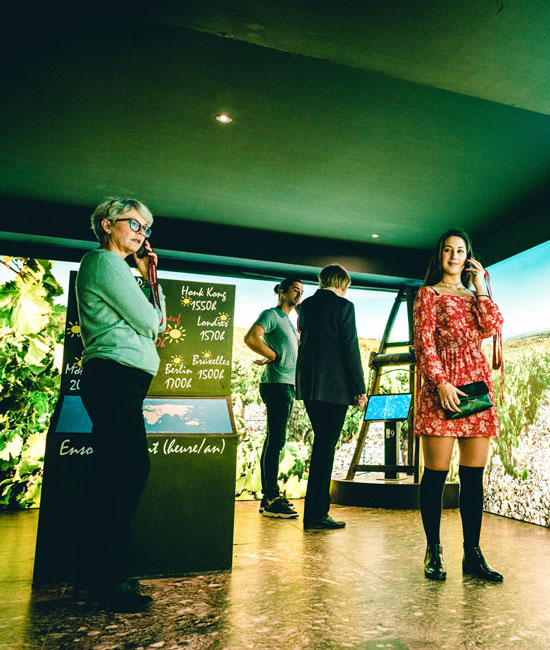
Top unique ways to discover the vineyards
Harvest time
The grape harvest is like a ballet: the harvesters seem to dance through the vines, secateurs in hand, and the tractors perform their own choreography as they transport the grapes to the wine cellars, with the promise of divine nectars in tow.
The harvest is also the time to dive into the history of wine in Vaucluse: trips along vineyard paths to learn all there is to know about the grape varieties, a break in a museum to discover the tools used in the vineyards, tasting workshops, and more – learn about the Vaucluse vineyards through objects, colours, and flavours!
Paths through the vineyards to discover the terroirs and grape varieties
Wine first and foremost signifies a vine, a grape variety, and a terroir: from the pebbly ground of Châteauneuf-du-Pape to the limestone foothills of Ventoux and the clay soil of the Luberon plain, set off to discover the Syrah, Mourvèdre, Cinsault, Clairette, and Bourboulenc…
Each path has its own story, a combination of know-how, mother nature, and man which led to the creation of wines that are sometimes internationally renowned, such as those of Châteauneuf-du-Pape, Séguret, Sablet, Beaumes-de-Venise… and sometimes more secret from the Ventoux and Luberon PDO.
Following a vineyard trail during the harvest has its own special charm: you can hear the grape pickers in the rows of vines, get drunk on the smell of freshly cut grapes, and imagine the wines that will be made from them!

Vineyards paths


Path in the vineyards of Château Pesquié
Mormoiron
From 01/01 to 31/12, daily.
From May till September : 10:00-12:00am/2.00-6.00pm every day.
From October till April : 10:00-12:00am/2.00-6.00pm from Monday till Saturday (except on January and February, closed on week-end).
You can’t talk about the vines without mentioning the winegrowers’ tool
You could say that the vine grower tames the vineyard. From the young plants to the century-old roots, the vine is shaped by the hand of the man who tends to it, prunes it, offers it supports, bends and shapes it, picks the leaves off, and monitors the growth of the bunches until perfect ripening for a successful harvest.
This story is told in the vigneron museums, including the Maison Brotte in Châteauneuf-du-Pape, the Musée des arts et métiers du vin in Ansouis, the Musée du Vigneron in Rasteau and the Musée de la truffe et du vin in Richerenches, where you learn all about cooperage, presses or everyday objects (pruning shears, grafters, wire tensioner, sprays etc.).
The next step, tasting the wines, can be done with glasses, carafes, and tastevins… Which sometimes prove to be true works of art!
A fascinating universe that we invite you to discover 😊

1 department, 3 appellations
Vaucluse has been a land of vineyards since Antiquity.
Before today’s winemakers, the Greeks, Romans, Templars, and Popes all lorded over the vineyards: each planted vines to accompany their feasts and banquets, and traded with other lands where the wines acquired their excellent reputation.
Although today the wines of Châteauneuf-du-Pape are world famous, the Grenache de Mazan was the star of its time, adorning the tables of Louis-Philippe.
So why don’t you follow the wine routes too, in search of the ideal wine for your table 😊

Did you know?
Vaucluse is also home to 8 vintages, and 2 natural sweet wines

Tasting session!

Les effluves des vendanges conduisent toujours à une cave où le vigneron sera heureux de vous accueillir pour une dégustation de ses meilleures cuvées, première étape gustative de vos papilles avec les cépages vauclusiens.
The aromas of the harvest always lead to a cellar where the winemaker will be happy to welcome you for a tasting of his best cuvées, the first gustative step of your taste buds with the Vaucluse grape varieties.
To refine your winemaker’s palate, the wine workshops of the Ecole des Vins d’Inter-Rhône allow you to learn about tasting and to discover the different aromas, food pairings and wines…
Perfect for lovers of good food and epicureans😉
Wine events

Latino evening at Domaine du Gros Pata
Vaison-la-Romaine
Saturday 27 July 2024 between 7 pm and 11 pm.

Sunsets Vignerons 2024 au Domaine de la Citadelle
Ménerbes
Tuesday 30 July 2024 between 6.30 pm and 10 pm.

Sunsets Vignerons in Luberon at Terrasses d’Adrien
Sannes
Tuesday 30 July 2024 between 6.30 pm and 9 pm.


The guinguette at Domaine LESCHANCEL
Mormoiron
Thursday 1st of August 2024 between 7.30 pm and 11 pm.

Les Je’dis vin – ‘Blue Maracas’ concert at Domaine la Ferme des Arnaud
Villedieu
Thursday 1st of August 2024 at 7 pm.

Sunsets vignerons 2024 à la Cave de Sylla
Apt
Tuesday 6 August 2024 between 6.30 pm and 10 pm.
Canceled or closed.

Winemakers in Luberon Sunsets at the Domaine du Collet Vert
Pertuis
Tuesday 6 August 2024 between 6.30 pm and 9.30 pm.










